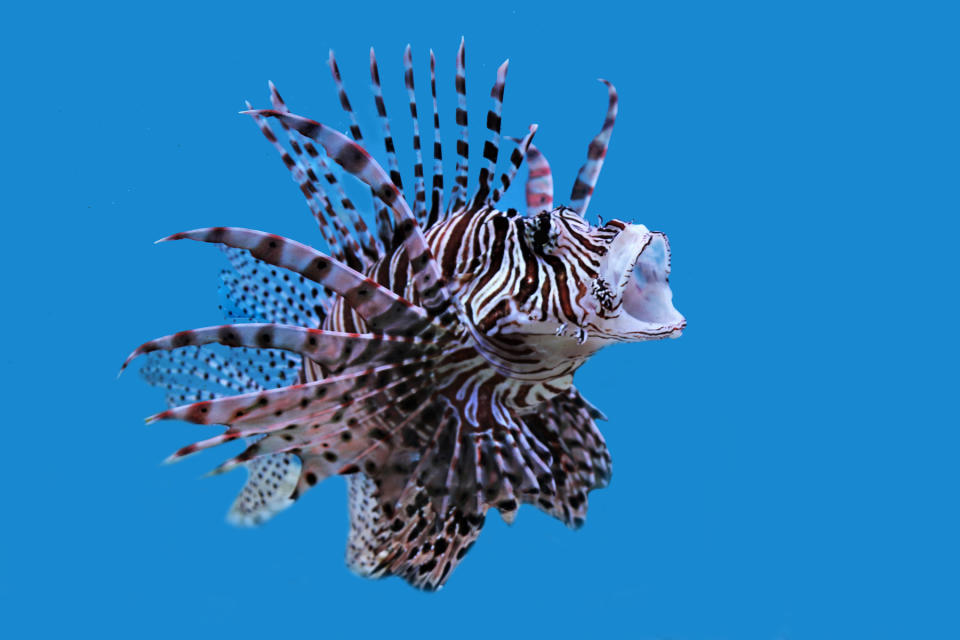‘Novelty’ Leather Features in New $125 Sandals

Last week, Grundéns, a company that sells fishing apparel and footwear, introduced its lionfish sandal at the Emerald Coast Open (ECO) in Florida, the world’s largest lionfish tournament, during its fourth year of competition targeting the invasive marine species. The flip-flop style footwear incorporates Inversa’s Invasive leather made from lionfish skin.
“Our support of the Emerald Coast Open and launch of the Lionfish Sandal underpins our commitment to helping maintain healthy fisheries around the globe,” Ash Williams, VP of marketing at Grundéns, said. “Invasive species of fish pose an immense threat to our marine ecosystems that millions rely on for their livelihood and recreation. Designing a unique and functional product while helping to mitigate issues that impact millions of commercial and sport anglers is very much part of our company value set.”
More from Sourcing Journal
The Swedish brand said it created the lionfish sandal as part of its commitment to sustainable products and resource conservation. Made in collaboration with Inversa, each sandal contributes to saving 25,000 native reef fish—the meal supply of lionfish, which “slipped undetectably” into the Atlantic Ocean in the 1980s from its native reefs of the South Pacific and Indian Ocean. Each venomous marine fish can eat up to 70,000 native reef fish in its lifetime, and females each lay over six million eggs every year. But nearly 24,700 lionfish were removed from the Gulf of Mexico during this year’s tournament, almost double what was caught last year.
“Grundéns is an amazing partner—they deeply care about our oceans and about protecting our Earth’s precious marine life that can’t advocate for itself, and their end consumer is just as motivated,” Aarav Chavda, Inversa’s co-founder and CEO, told Sourcing Journal.
Retailing for $125, the sandal features a full-grain leather footbed and straps with an Inversa Invasive leather lateral strap panel made from lionfish skin—some of which was harvested by local fishermen who participated in ECO. Sold in men’s sizes 9-13, it also features a natural gum rubber outsole for improved traction on wet surfaces, medial arch support and quick-drying foam.

Inversa views its leather as regenerative, considering that removing one lionfish from the ecosystem saves up to 70,000 native reef fish and allows the reefs to recover. It teams with spear divers to capture the fish from the Caribbean, South America and the United States. Then it sends their skins off to a Cincinnati-based tannery specializing in exotic hides, where they are treated with Chrome III. The leather is engineered to stand up to automotive-grade testing as the lionfish’s skin features a tight, fibrous collagen matrix that’s strong, durable and highly manufacturable.
“We’re turning the fashion industry into our planet’s hero,” Chavda said. “Actions have consequences, and for the first time in history, a pair of sandals can save coral ecosystems. That’s pretty special.”
According to Tiffany Hua, an analyst specializing in material innovation with Boston research and advisory firm Lux Research Inc., Inversa and anyone else in the lionfish leather business may face the challenge of making the leather scalable and cost-effective.
“Other regions in Europe have existing fishery economies and cultures that serve as a backbone for the fish leather market. Here, Inversa must develop their market by bringing attention to the cause and their product and navigating consumer acceptance for these types of products,” Hua told Sourcing Journal. “There may be resistance to mass market adoption due to the exotic look where it will likely remain a niche market. However, [with] Inversa targeting a more sustainable market in this partnership with Grundéns, there may be more acceptance for fish leather.”
In terms of properties, fish skins are smaller and thinner when compared to leather from cows and other land animals. When it comes to production, however, fish leather presents challenges such as inconsistent quality, size and shapes of skins as compared to traditional animal leather, Hua said. Those additional challenges make its operationalization more expensive than conventional cow leather production. For lionfish, there’s likely a higher cost to production given that it’s smaller than the salmon typically used for fish leather.
“Lionfish leather is certainly a novelty and more representative of the conservation efforts rather than the practical use of the material,” Hua said.

